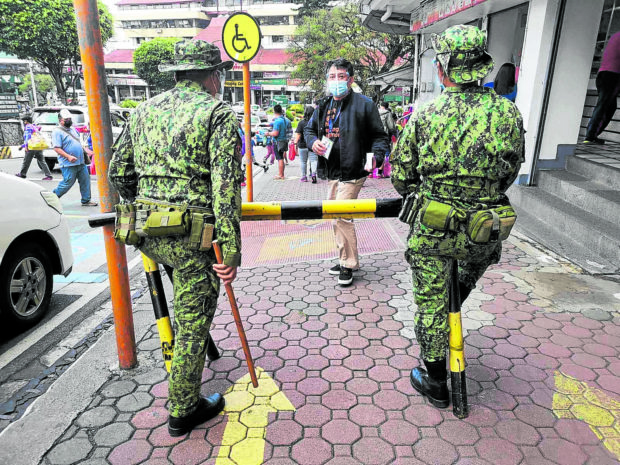Baguio to train Metro Manila’s contact tracers

TRAFFIC FLOW Pedestrians walking through downtown Baguio City streets get directions from police officers tasked to handle one-way traffic flow, a protocol introduced last year to prevent crowding during the pandemic. The city has also perfected its virus tracking system that it will now share with contact tracers in Metro Manila. —EV ESPIRITU
BAGUIO CITY, Benguet, Philippines — At least 850 contact tracers, including 250 policemen in the National Capital Region (NCR), will be trained by the city’s tracking team to detect suspected carriers of the coronavirus disease in the so-called NCR Plus bubble, Mayor Benjamin Magalong said on Monday.
The NCR Plus bubble refers to the containment zoning of Metro Manila and the surrounding provinces of Bulacan, Laguna, Cavite and Rizal.
These areas were placed on enhanced community quarantine (ECQ), the strictest form of lockdown, from March 29 to April 4 due to the surge in COVID-19 infections.
Included in the training are 600 people hired by Metro Manila mayors as contact tracers in coordination with the Metro Manila Development Authority starting March 31, Magalong said during the flag-raising ceremony.
Magalong, the government’s testing czar on a hold-over capacity, is known for combining the skills of epidemiologists and police investigators in locating close contacts or virus-afflicted patients.
The contact-tracing procedure was devised in Baguio at the onset of the pandemic last year.
Magalong said five contact tracers used to be assigned to one infection case, citing the need to dig beyond the household, classified as first generation contacts of the COVID-19 patient, or the neighborhood, or the second or third generation contacts of the first contacts.
“We once detected 93 (sixth generation) contacts of a patient with a COVID-19 variant, and 130 more contacts of another variant case,” he said.
But contact tracing results have lagged behind in recent months because manpower had dropped to 30 percent of the original 50,000 trackers employed by the government, he said. Budget cuts were among the reasons for the reduced tracking workforce.
“Now it’s the reverse. One contact tracer handles four to five cases, and a backlog develops because the number of infections increase while he is busy clearing the first or second cases. That’s how their workload builds up,” Magalong said.
Local governments also have to review contact tracing data because of errors committed by encoders.
According to Magalong, continued testing and border controls are key to keeping the disease at bay.
He said many communities felt the increase in infections after borders were opened without any restrictions and tests.
Relaxed guidelines
Outside of the NCR Plus bubble, the Inter-Agency Task Force for the Management of Emerging Infectious Diseases (IATF) continued to relax travel guidelines to accelerate economic recovery.
The IATF allowed local governments the option to require border tests, but limited to reverse transcription-polymerase chain reaction (RT-PCR) tests, which many travelers could not afford.
Baguio was recently allowed to use rapid antigen tests on leisure travelers when it was placed under its second general community quarantine. But the city’s tourism office has barred travelers originating from the NCR Plus bubble last week, even if Metro Manila and Central Luzon represent 70 percent of its tourist market.
The city has also been reeling from high transmission cases. On March 28, Baguio recorded 114 new infections and three deaths.
Strong border control
“It is important [that] we have a strong border control,” Magalong said.
The impact of the virus transmission in the NCR Plus areas may only be felt 10 to 15 days later, he added.
“Incubation of the virus takes five days, and if symptoms are felt, the person may resort to self medication,” Magalong said.
It may take three days later when the patient seeks medical attention and will be told to get an RT-PCR test that will take another two to four days to yield a result, he said.
Magalong also reminded that the fist bump, which replaced handshakes in a world changed by the pandemic, could transmit the disease.
The possibility that skin contact can be infectious was earlier raised by a World Health Organization official who discussed one such incident, he said.
Magalong added: “We would rather advocate elbow bumps in greeting people.”
For more news about the novel coronavirus click here.
What you need to know about Coronavirus.
For more information on COVID-19, call the DOH Hotline: (02) 86517800 local 1149/1150.
The Inquirer Foundation supports our healthcare frontliners and is still accepting cash donations to be deposited at Banco de Oro (BDO) current account #007960018860 or donate through PayMaya using this link.